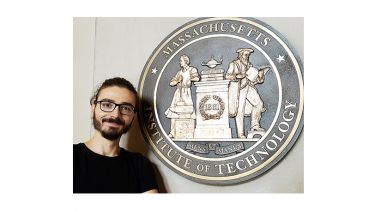I chose tissue engineering because it has a tangible impact on human beings

Can you tell us a bit about your research?
My PhD project involves developing biomaterials and systems for studying and promoting angiogenesis (the formation of new blood vessels) and for tissue engineering applications. Delayed angiogenesis of tissue-engineered constructs is a major barrier for the translation of these constructs to the clinic - thus, angiogenesis is crucial for almost all tissue engineering applications.
Accordingly, my research includes developing synthetic and natural tissue-engineered constructs to study the aspect of angiogenesis and exploring novel angiogenic agents as alternatives to expensive and well-established drugs.
All of these studies aim for a single goal; to better understand the complex nature of angiogenesis and how we can contribute efficiently to this field. For further details of the developed biomaterials and angiogenesis systems, see the published articles.
Why did you choose your area of research?
This is a very comprehensive question. The short answer is that I chose tissue engineering because it has a tangible impact on human beings.
I'm a bioengineer, and my job definition is to engineer systems to circumvent health-related problems. Tissue engineering is one of the most powerful tools we hold to create hope for people who suffer from a disease or from an injury, by replacing biological tissues with bioengineered ones.
That's why exploring something new and potentially useful for humanity is the most momentous thing for me, and this is my driving force to go to the lab and research every day.
What have you enjoyed most about your work so far?
I really enjoyed the multidisciplinary tasks that we've been working on throughout my PhD. I usually think of the complex research problems as a puzzle - the only way of solving a research problem outside of our current knowledge, is to collaborate with other scientists to bring all the pieces of the puzzle together.
I had the privilege of collaborating with scientists either within or outside the UK on different projects. I guess gaining new perspectives from our collaborators and figuring out new approaches to research problems were the parts of my research that I most enjoyed.
I believe the city of Sheffield has a unique soul, which inspires creativity and innovation.
Serkan Dikici
PhD Engineering Materials
You recently got the opportunity to travel to MIT to carry out some of your research. Can you tell us what you did while you were there?
Conducting collaborative research with MIT was a great experience in every aspect. Besides the tremendous laboratory facilities which I had the privilege of using, most of them at MIT, I met so many scientists who are pioneering in the field of biomaterials and tissue engineering. My project was based on developing a 3D dynamic model to enable the study of angiogenesis in vitro in a more physiologically relevant environment.
This collaborative project was an important step in order to reduce the use of animals in vascularisation studies, and the results we obtained from our experiments were really encouraging for us to share them with other scientists. Therefore, we presented our study at BioMedEng2019 in Imperial College London and submitted an original research article.
What are your ambitions for the next few years?
In the short term, I am focused on finishing my PhD project and obtaining my doctorate degree from the University of Sheffield. My PhD scholarship provider is the Turkish Ministry of National Education, and they anticipate that all students go abroad and learn as much as possible, returning to the Republic of Turkey equipped with the most up-to-date knowledge in their field.
Therefore, I will return to my beautiful coastal city of Izmir, and continue my research in a vibrant, comprehensive university, the İzmir Institute of Technology. Of course, I will always remain in contact with my supervisors in Sheffield, as well as other scientists for future collaborations.
Can you tell us a bit about what you like about being part of the University of Sheffield, and living in the city?
I would say that being here at The University of Sheffield is an invaluable opportunity. I have two enthusiastic supervisors - Professor Sheila MacNeil and Dr Frederik Claeyssens - and an excellent research group, which facilitates focus on my research.
Besides the great people supporting my research, the University of Sheffield offers countless facilities and equipment for its students. I would say researching at the University of Sheffield is one of the most worthwhile experiences I have ever lived.
Sheffield, for me, is a city for which I can make an analogy with a Swiss pocket knife - it's small, but it has everything you need. It is the exact dictionary definition of 'student city'. I believe the city of Sheffield has a unique soul, which inspires creativity and innovation. The "Steel City" will always stay as my second home.
Dikici, S., Mangir, N., Claeyssens, F., Yar, M., and Macneil, S. (2019c). Exploration of 2-deoxy-D-ribose and 17β-Estradiol as alternatives to exogenous VEGF to promote angiogenesis in tissue-engineered constructs. Regen. Med. 14, 179–197. doi:10.2217/rme-2018-0068.
Dikici, S., Claeyssens, F., and MacNeil, S. (2019b). Decellularised baby spinach leaves and their potential use in tissue engineering applications: Studying and promoting neovascularisation. J. Biomater. Appl. 34, 546–559. doi:10.1177/0885328219863115.
Dikici, B. A.*, Dikici, S.*, Reilly, G. C., MacNeil, S., and Claeyssens, F. (2019a). A Novel Bilayer Polycaprolactone Membrane for Guided Bone Regeneration: Combining Electrospinning and Emulsion Templating. Mater. 2019, Vol. 12, Page 2643 12, 2643. doi:10.3390/MA12162643.*equally contributed co-first authors
Mangir, N., Dikici, S., Claeyssens, F., and Macneil, S. (2019). Using ex Ovo Chick Chorioallantoic Membrane (CAM) Assay to Evaluate the Biocompatibility and Angiogenic Response to Biomaterials. ACS Biomater. Sci. Eng. 5, 3190–3200. doi:10.1021/acsbiomaterials.9b00172.
Azam, M., Dikici, S., Roman, S., Mehmood, A., Chaudhry, A. A., U Rehman, I., et al. (2019). Addition of 2-deoxy-d-ribose to clinically used alginate dressings stimulates angiogenesis and accelerates wound healing in diabetic rats. J. Biomater. Appl. 34, 463–475. doi:10.1177/0885328219859991.

